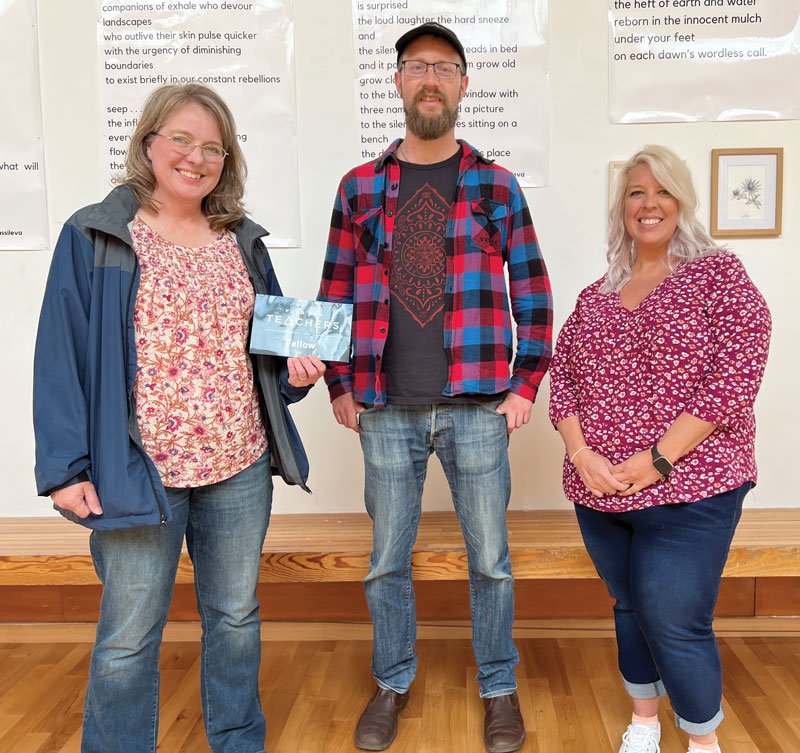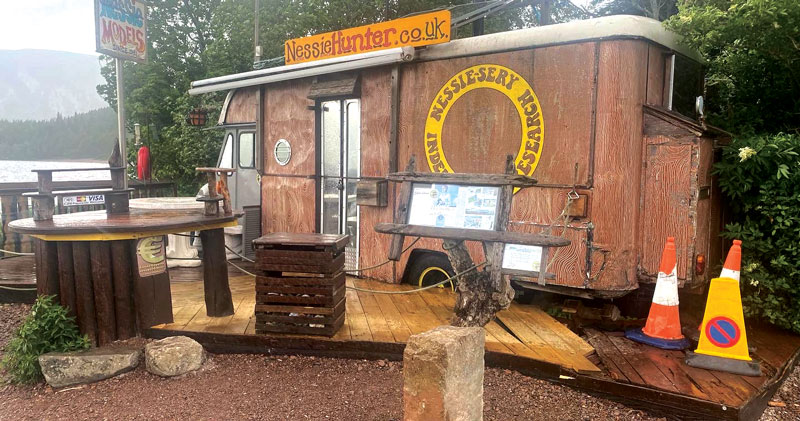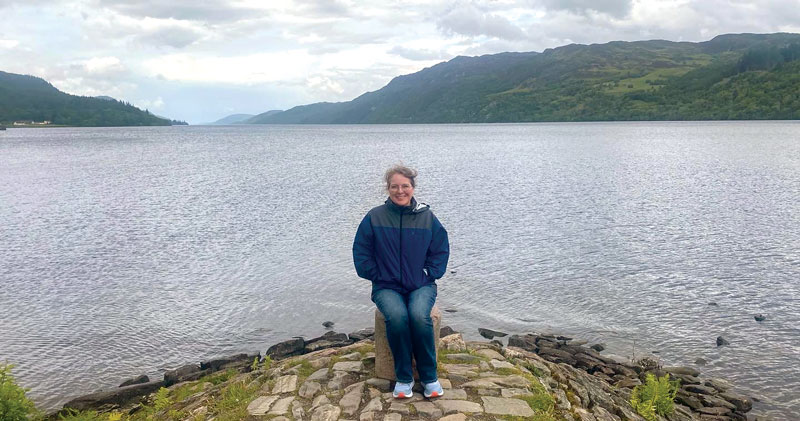Alabama Educators Earn Grant for Trip to Scotland to Spark Students’ Reading and Writing
Walnut Grove Elementary School librarian Holly Whitt and third grade classroom teacher Lori Alexander created their own professional development program to meet their students needs. The pair financed the program through a grant from Fund for Teachers.
 |
Holly Whitt (left) and Lori Alexander (right) with Bespoke Storytelling Facilitator Dougie Mackay at the Scottish Storytelling CentrePhotos courtesy Lori Alexander |
School librarian Holly Whitt and her third grade classroom teacher colleague Lori Alexander had tried everything to get their students at Walnut Grove Elementary School in New Market, AL, to read more. Battle of the Books. Reading challenges. Rewards of pizza and ice cream. But nothing succeeded in sparking the students’ interest in reading or bettering their reading comprehension. And reading wasn’t the only struggle.
“Our kids are really good at telling stories,” says Whitt. “They talk and tell stories all day long. But if you put a piece of paper in front of them, and you ask them to write a story for you, or write about something they learned about in class, they freeze, and they can’t do it. They won’t write more than a sentence or two.”
The two started to consider how all of those pieces—reading, writing, and oral storytelling—came together.
“We began thinking about the connection between writing and reading, and the strong research showing that better readers make better writers,” says Whitt. “As we continued to struggle with ways to get our students excited about reading, however, we concentrated on how often they enjoy telling stories about their own lives. That made us think we might approach the reading-to-writing connection in a more circular fashion. Instead of focusing just on reading or just on writing, we thought that helping them connect oral storytelling, which they were already good at informally, to more formal reading and writing, then we might be on to something.”
But what would help them reach their goals? They knew of no established lesson, program, or professional development (PD) that met their needs. Whitt, however, did know about an organization that enables educators to craft their own PD plan and apply for grants. Fund for Teachers (FFT) awards summer fellowship grants for Pre-K through 12th grade educators “to pursue self-designed professional learning.” Individuals may apply for up to $5,000, and teams can receive up to $10,000 in funding.
Whitt and Alexander had to clearly show the need in their school and map out how their PD idea would address it. As they researched, they learned that 2022 was the Year of Stories in Scotland, a themed year of visits put together by VisitScotland. Also wanting to take a trip together, the two saw the perfect opportunity to learn, re-energize, and share an experience they could bring back to their students in myriad ways.
“[We were] just trying to reach as far as we could, all the way to Scotland, to try to find something that would spark their imagination,” says Whitt.
FFT saw the vision in the “ Storytelling Connections in Scotland” proposal and funded their learning adventure. With that, in the summer of 2022, Whitt and Alexander set off for Scotland. The trip took them to Edinburgh Castle; the Scottish Storytelling Centre; the National Library; and of course Loch Ness, the watery home of Nessie the Loch Ness Monster, among other locations.
“I learned lots of different strategies that I had not thought of before that helped not just with storytelling and writing, but also with reading comprehension,” says Alexander.
 |
The hunt for Nessie has captivated the educators’ elementary students. |
In a workshop called “chatting the story,” the instructor told a story and Alexander, Whitt, and others had to retell the story or share one of their own. Alexander struggled during the exercise, and noted how she and Whitt completed the assignment in different ways.
“It just reminded me that not all my students are going to perform well with the task I give them,” said Alexander.
Instead, she realized, she could offer a choice of assignments that would each show if students mastered what Alexander wanted to evaluate.
Since they returned, the educators have worked the trip and what they learned into lessons in a variety of ways—and it’s working.
While they don’t have test scores or any kind of hard data to support the impact yet, the two see it in increased interest from the kids and the projects students have taken on.
“You just kind of feel a vibe around it, I guess,” says Whitt. “I do think that kids are more interested.”
Students started a podcast about local history, which required interviewing local people and writing out an outline beforehand. In addition, a small group of sixth graders is writing a book.
“That’s something that I don’t think I would have tried without having [the trip],” Whitt says of the book project. “They first tell their story out loud to each other—what is the story about, how’s it going to unfold? Then they write a couple of chapters, and they come back and read it and talk some more about what should happen next, how a character [is] going to change and a new character will be introduced.”
The process shows students how stories translate back to the page.
She has also used the trip to tie into sharing and uncovering stories of local history. She and Alexander went to an old village from the Middle Ages and learned about crafts they did at the time. When she came back to school, she could connect that back to their local museum with items from hundreds of years ago and talk about traditions, artifacts, and the kinds of stories you can tell from them.
“They can see that stories are not static, they’re not just found in pages,” says Whitt. “They are found in objects. They’re found in communities and people and landmarks, plants, everything.”
Participating in this professional development adventure with a colleague helped both of them once they got back to school.
“Of course, everybody’s their own kind of learner, I get that, but I think having somebody else to come back and build off of those ideas with is really helpful and crucial to being able to implement something well,” says Whitt.
Alexander’s hands are tied a bit more by the strict curriculum she must follow in the classroom, but she is finding a way to work her experience and what she learned in Scotland into different subjects across the curriculum.
 |
Whitt at Loch Ness.Courtesy of Holly Whitt |
“Anytime I can plug in my trip and what we did there, I do,” she says, noting that she spoke about her trip to Loch Ness during a social studies discussion and made a literature connection as well. “Our first unit is fairy tales, and the [book] is The Wind in the Willows. The author is from Scotland, so we were able to talk about that and pull up the globe and show where he was from and just talk about the difference in the language and the words that they use. It’s great for our kids, because they don’t have a lot of exposure to those types of things.”
In addition to what they learned that summer, Whitt and Alexander have ongoing access to FFT resources through the Ramsden Project, which connects past fellows and provides them support as well as the opportunity to secure mini-grants to continue and grow the PD project after the initial fellowship. The extra post-fellowship support helps educators to follow through on what they learned and allows the initial idea to continue to evolve as it’s implemented in school.
“This was not just a one-time [thing]—you got the grant, you went somewhere, and you came home and you tried to implement it by yourself,” says Whitt. “They are always involved and always supportive of everything else that you do. I think it’s the best thing I ever did.”
The educational adventure to Scotland re-energized Whitt and Alexander, pushed them to think about teaching in a new way, and ignited a new level of curiosity in their students. As the educators share and implement lessons from the trip and skills they were taught, kids are learning about the world and how storytelling connects to all subjects and makes reading and writing more interesting and exciting. In the process, the kids at Walnut Grove Elementary made a huge discovery—in one of Alexander’s photos from Loch Ness, the students are sure a “shadow” in the image is actually Nessie!
RELATED
The job outlook in 2030: Librarians will be in demand
The job outlook in 2030: Librarians will be in demand
ALREADY A SUBSCRIBER? LOG IN
We are currently offering this content for free. Sign up now to activate your personal profile, where you can save articles for future viewing





Add Comment :-
Be the first reader to comment.
Comment Policy:
Comment should not be empty !!!